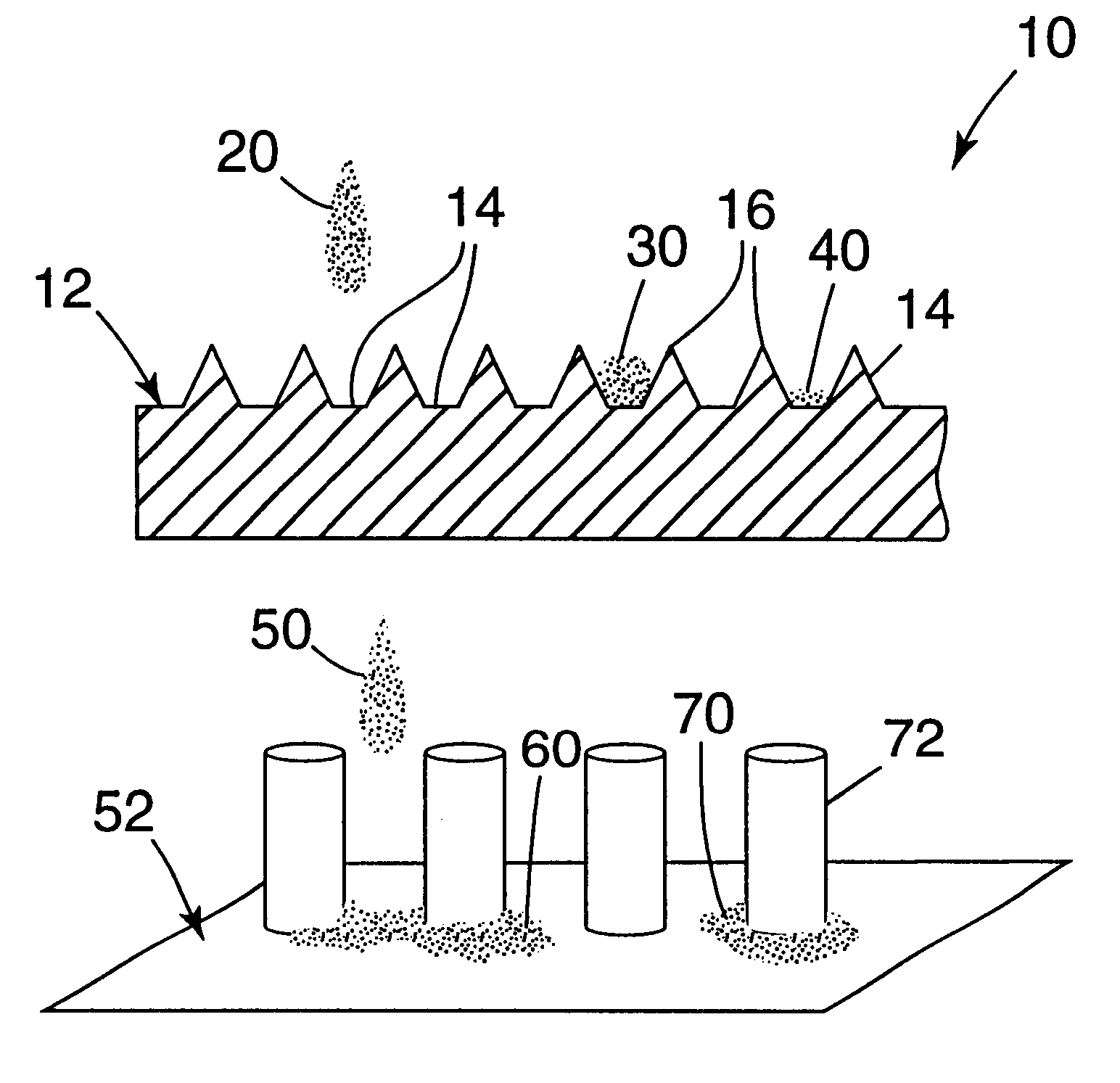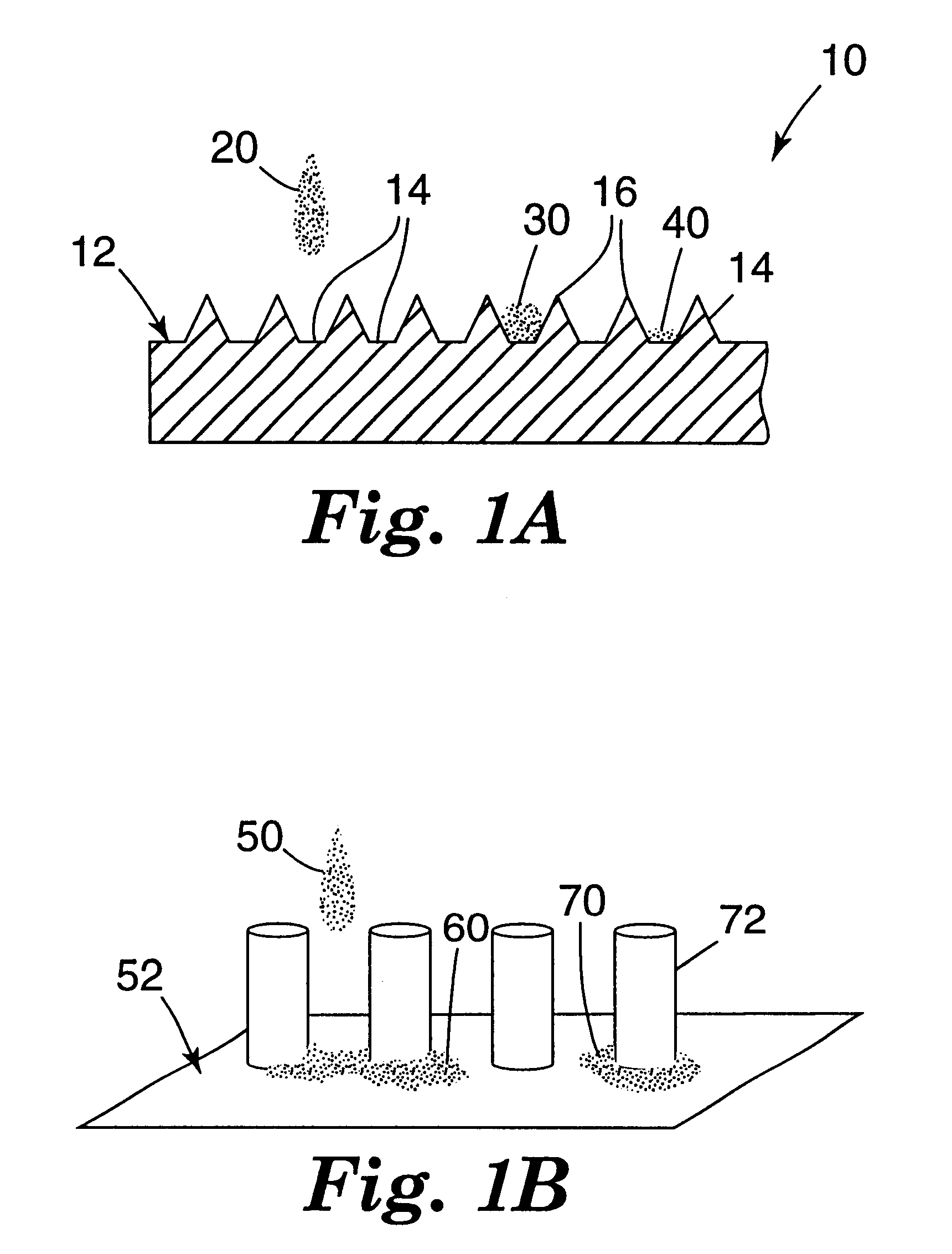Embossed receptor media
a receptor media and embossing technology, applied in the field of embossing receptor media, can solve the problems of increased media and ink consumption, water-sensitive polymer layer, image graphics of inkjet receptor media, etc., to prevent feathering or bleeding of image, protect inkjet image, and minimize the surface area of dried ink.
- Summary
- Abstract
- Description
- Claims
- Application Information
AI Technical Summary
Benefits of technology
Problems solved by technology
Method used
Image
Examples
example 1
Swellable Substrates, Coated then Embossed
3M Thermal Inkjet Media 3657-10 was removed from the finished roll with coating, adhesive, and liner intact and set against the CCP embossing mold in a hot press. Conditions which work well for both the 3657-10 and 8502 media were 1.0.times.10.sup.5 kPa at 143.degree. C., both platens, for two minutes. Thus the media was embossed after the inkjet receptor coating was applied.
After embossing, the sheets were, cooled and reinserted in the NovaJet III printer for print tests. The print cartridges in the NovaJet III are Hewlett Packard 51626A type and these were filled with 3M's cyan, magenta, yellow, and black pigmented inks (Yellow: TB14002, Lot 01x2; Magenta: TB14003, Lot 01x2A; Cyan: TB14001, Lot 01x2; Black: TB14004, Lot 2A), The print lest called CIRCLES is a simple pattern of the three primary colors (cyan, magenta yellow) which overlap to form secondary colors (blue, red, green) with 200% ink and a three color (300% ink) black at the cen...
example 2
Olefin Embossed and Coated with Salt / Surfactant
The CUBE and PYR1 pattern were extrusion embossed on Union Carbide 7C50 (a propylene-ethylene random copolymer). The embossed sheets were coated with a salt / surfactant dispersion, the components of which are listed in the table below. Coating was accomplished using a #3 Mayer rod, a coating rod manufactured by RD Specialties of Webster, N.Y., followed by low heat drying with a heat gun.
The coated 7C50 sheets were printed upon using an Encad NovaJet 4 equipped with 3M pigmented inks. The CIRCLES pattern was used to illustrate printing properties. As a control embossed uncoated sheets were printed in the same manner. (A second control, coating onto a flat 7C50 sheet, could not be carried out: the resulting dried coating leaves large salt crystals and sticky puddles of surfactant. The embossed recesses allow for deposition of the material without visible or tactile changes.)
The embossed and coated samples produced very good image quality i...
example 3
Transparency of Embossed Substrates on an Overhead Projector
PET copolymer Easter 6763 from Eastman Chemicals, was extrusion embossed with flour patterns for comparison, to an extruded, unpatterned sample of Eastar 6763 as observed as a projection onto a white background from an overhead projector. Using 3M's 9600 overhead projector, the first pattern, CUBE, produced a projection which was as clear as the control sample. RECT also produced a clear projection. PYR2 projected a gray image, and CCP projected a black image.
A sample of 4 mil (0.101 .mu.m) PET sheeting embossed with the POST pattern was also observed to give a clear projection under the same conditions.
PUM
| Property | Measurement | Unit |
|---|---|---|
| Fraction | aaaaa | aaaaa |
| Angle | aaaaa | aaaaa |
| Volume | aaaaa | aaaaa |
Abstract
Description
Claims
Application Information
 Login to View More
Login to View More - R&D
- Intellectual Property
- Life Sciences
- Materials
- Tech Scout
- Unparalleled Data Quality
- Higher Quality Content
- 60% Fewer Hallucinations
Browse by: Latest US Patents, China's latest patents, Technical Efficacy Thesaurus, Application Domain, Technology Topic, Popular Technical Reports.
© 2025 PatSnap. All rights reserved.Legal|Privacy policy|Modern Slavery Act Transparency Statement|Sitemap|About US| Contact US: help@patsnap.com



